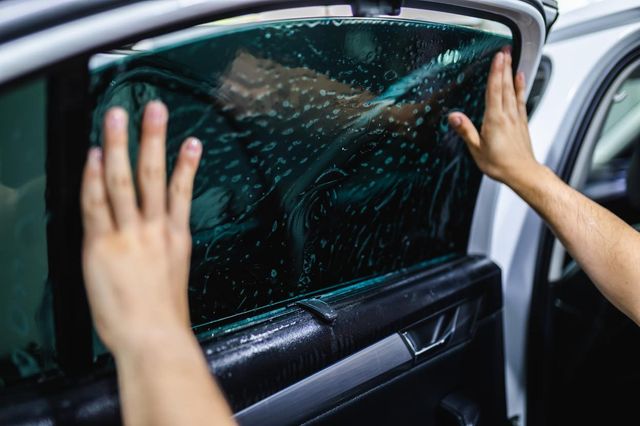Why Automobile Window Tinting is a Must-Have for Modern Autos
Why Automobile Window Tinting is a Must-Have for Modern Autos
Blog Article
Window Tinting Rules and Guidelines: What You Need to Know Prior To Tinting Your Vehicle
Prior to waging window tinting for your car, it is important to familiarize yourself with the varied laws and standards that govern this method throughout various states. These policies determine the allowable degrees of tint darkness, commonly gauged by visible light transmission (VLT) percentages, and consist of specific terms for front windshields intended at ensuring roadway safety and security. In addition, specific jurisdictions may supply medical exceptions for individuals with certifying problems. Recognizing these intricacies can conserve you from prospective legal ramifications, yet what are the details guidelines in your state?
Review of Home Window Tinting Regulations
Home window tinting legislations are regularly based on variation across various jurisdictions, reflecting local laws and safety factors to consider. These regulations dictate the acceptable degrees of tint darkness and reflectiveness on lorry windows, making sure that chauffeurs keep appropriate visibility while additionally securing against dangerous UV rays and warm.
Many policies classify home window tinting based upon the Visible Light Transmission (VLT) percent, which indicates the amount of light that can go through the window. Usually, reduced VLT percentages represent darker colors. Regulations usually separate between the front, side, and back home windows, with stricter constraints put on the front windshield to improve safety for both the motorist and various other roadway individuals.
In addition, some territories enforce restrictions on the reflectivity of the tint, stopping excessive glow that can impair visibility. Exceptions to these laws might exist for individuals with specific clinical problems requiring additional sun security. Compliance with window tinting policies is important, as violations can lead to penalties, necessary removal of the color, and prospective rises in insurance policy premiums. For that reason, it is crucial for automobile proprietors to acquaint themselves with local legislations prior to waging home window tinting setups.
State-by-State Color Rules
Recognizing the particular home window tinting regulations in each state is important for automobile proprietors looking for to conform with the legislation. Each state in the united state has actually established its own collection of rules regulating window tinting, which can differ significantly. These policies commonly determine the permitted levels of color darkness, the kinds of home windows that can be tinted, and any kind of medical exemptions that might apply.
For example, states like The golden state have strict restrictions on tint darkness for front home windows, while others, such as New Mexico, might enable darker colors. In addition, particular states mandate certain exposure portions for different home windows, consisting of the windscreen, front side home windows, and rear windows. It is vital for cars and truck proprietors to familiarize themselves with their state's legislations to stay clear of possible penalties or fines.
Moreover, some states might require a certification sticker label to be put on colored home windows, showing conformity with state regulations. Failing to stick to these policies not only takes the chance of legal effects but can also affect safety and presence while driving. Automobile owners must perform detailed research study or consult neighborhood authorities to make sure complete understanding and compliance with state-by-state tint laws.
Allowed Tint Types and degrees
Lots of vehicle owners may be stunned to learn that enabled color levels and kinds vary extensively throughout different states. Each state has established its own guidelines regarding the permitted darkness and reflectivity of window color, often measured by Visible Light Transmission (VLT) portions. VLT describes the quantity of light that can go through the tinted windows; hence, a lower portion shows a darker color.

In addition, the kinds of color products allowed can differ, with some states forbiding metal or mirror-like finishes. It is important for lorry owners to familiarize themselves with their state's particular legislations to make sure conformity. Non-compliance can cause fines, required removal of the tint, or other lawful effects, making it essential to comprehend these policies before waging installment.
Medical Exemptions for Tinting
While not all states offer allowances for medical exemptions concerning window tinting, those that do recognize the necessity for specific people to improve visibility and convenience as a result of clinical conditions. Various clinical problems, such as lupus, skin cancer, and certain eye disorders, can render people especially sensitive to sunlight. Consequently, these individuals may call for darker tints to secure themselves from unsafe UV rays and glare.

It is essential to note that despite having a clinical exemption, there may still be restrictions on the level of color enabled. Conformity with state legislations makes sure that individuals are both safeguarded and within legal limitations. Those taking into consideration medical exceptions must call their neighborhood Department of Electric motor Autos or equivalent authority to understand the treatments and requirements needed to make an application for an exception efficiently.
Penalties for Non-Compliance
Failing to follow home window tinting laws can bring about significant charges, which vary by state. Legislation enforcement firms are empowered to issue citations for vehicles that do not comply with the defined tinting regulations. These penalties usually include fines, which can range from small amounts to numerous hundred dollars, depending upon the intensity of the offense and the state in concern.
In some territories, duplicated offenses may lead to rising fines or additional fines, such as obligatory court appearances. Additionally, non-compliance may require the elimination of unlawful tinting, usually at the proprietor's expenditure. In severe cases, habitual culprits may face suspension of their automobile registration until conformity is achieved.
Additionally, insurance coverage ramifications may occur from obtaining multiple citations for home window color infractions. Insurance firms may check out such offenses as a sign of riskier behavior, possibly bring about boosted premiums or problem in insurance coverage.
To stay clear of these penalties, it is vital for lorry owners to acquaint themselves with their local home window tinting regulations and make certain that their vehicle complies (Window Tinting). This aggressive strategy not only prevents legal implications but likewise promotes roadway safety
Conclusion

Many policies categorize home window tinting based on the Visible Light Transmission (VLT) percent, which shows the amount of light that can he said pass through the window. Conformity with home window tinting regulations is essential, as infractions can result in fines, necessary elimination of the color, and possible increases in insurance premiums.Understanding the particular window tinting policies in each state is essential for vehicle proprietors looking for to conform with the legislation. These guidelines usually determine the allowable degrees of color darkness, the kinds of windows that can be tinted, and any type of clinical exceptions that might use.
For circumstances, states like California have strict limitations on tint darkness for front windows, while others, such as New Mexico, may enable darker tints.
Report this page